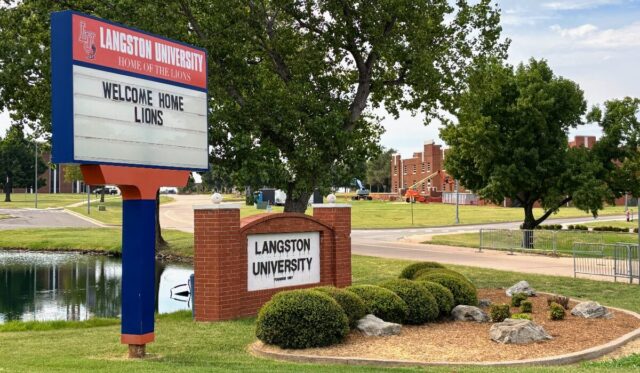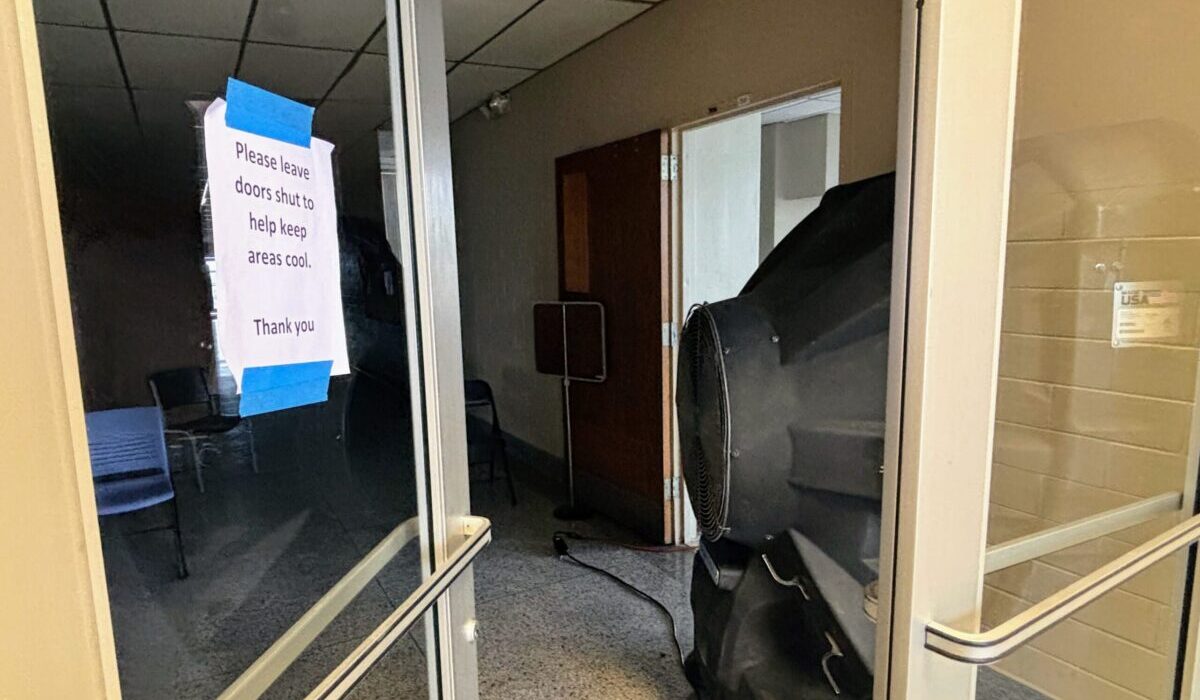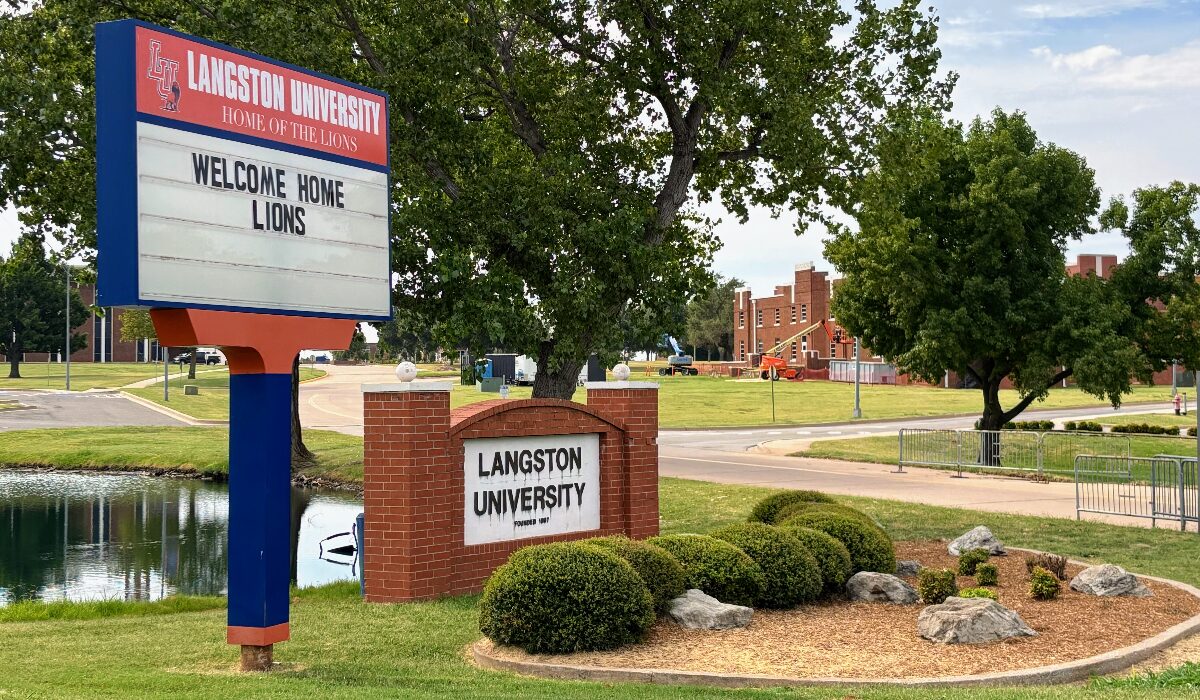


LANGSTON — Since the fall semester started Aug. 5, multiple buildings on the Langston University campus have been closed because of several infrastructure issues, such as broken air-conditioning units, newly found asbestos, water outages and a burned-out mechanical motor component in the campus boiler system.
The stressful situation has left professors frustrated that they must revert back to the “Zoom University” online learning model they thought they’d mostly left behind in the pandemic. Students are annoyed, too, and a recent announcement that Langston received $3.5 million this summer to fix “deferred maintenance” issues has only added confusion about why campus buildings remain offline heading into the fifth week of the new school year.
“It’s frustrating, because trying to find classroom space right now is almost impossible as it is,” said Mick Howard, an English professor who has taught at Langston for a decade. “We just want to do our jobs. We want to be with students. Everybody’s burned out on Zoom as it is from COVID. The students are burned out on Zoom, and it’s hard to engage.”
New Langston University President Ruth Ray Jackson confronted concerns about the heating, ventilation and air-conditioning issues during her State of the University address Aug. 29 at the semester’s opening convocation.
“Like many institutions in Oklahoma and throughout the country, the deferred maintenance needs of our campuses far outpace the revenue or appropriations allowed to address those needs,” Jackson said. “We’re working to find sustainable solutions that fit within the parameters of our procurement and policy outlines.”
The Oklahoma Legislature acknowledged the deferred maintenance needs across the higher education system this session, designating $157.5 million for lingering building and infrastructure needs at more than two dozen Oklahoma institutions. The new fiscal year began July 1.
Langston — founded in 1897 as Oklahoma’s only historically Black college or university — is receiving $3.5 million of that money, Jackson told the campus community.
But according to Jackson, up to $2.5 million of Langston’s deferred maintenance allocation will be used to install a new roof on the former News 9 headquarters donated to Langston’s journalism program in 2022. That leaves about $1 million for deferred building projects on Langston’s main campus in Logan County. The university comprises most of the town of Langston, one of Oklahoma’s original all-Black municipalities.
While Langston students are often unsure how university appropriations are allocated, some 2024-2025 enrollees believe the funding dedicated to rebuild the OKC campus roof should have been allocated toward repairing air-conditioning units on the main campus, which currently lacks enough functional buildings to hold classes that were supposed to be in-person.
“I heard people talking about [Jackson] having $2.5 million to go to the roof on the OKC campus instead of the AC,” said Langston junior Sade Bass. “That’s a problem. That money needs to go toward the AC.”
Howard, who also serves as director of the university’s writing center, expressed his frustration about the maintenance issues while also stating the problems are “not largely Langston’s fault.”
“There has always been maintenance issues, but the effects of this are probably the biggest since I’ve been here,” Howard said. “We’re struggling to keep up. We are an older university that has not had enough funds to adequately maintain, so we have to put band aids on things.”
Langston students: Distance learning ‘sucks’
While fixing the air conditioning in campus buildings might sound simple enough, problems have mounted as the university seeks solutions.
Sanford Hall, one of the oldest and largest buildings on Langston’s campus, must undergo additional repairs before the HVAC system can be replaced because inspectors recently discovered asbestos — a heat-resistant mineral fiber formerly used in construction materials.
Asbestos exposure can only occur if “asbestos-containing” materials are disturbed and particles are released into the air, according to the U.S. Environmental Protection Agency. Heavy or reoccurring exposure can increase the risk of developing lung cancer.
Asked about the asbestos and other issues on campus, assistant director of communications Jett Turner provided a lengthy statement, which can be found below in its entirety.
“As long as asbestos is undisturbed it is safe, and the asbestos within Sanford Hall has not been disturbed,” Turner said. “In order to install a new chiller within the building, the asbestos will need to be safely removed. The abatement of the asbestos is part of the plan Langston University has to replace the chiller.”
As the university waits to renovate its new OKC building, Sanford Hall has housed Langston’s broadcast journalism program — a hands-on degree plan with print, radio and TV news media components.
Broadcast journalism student Jasilyn Spivey said returning to remote classes and the inability to access equipment in Sanford Hall has negatively impacted student studies and morale this semester.
“Even today, my professor was talking about wanting us to get back on campus so we can take the test that we need to,” Spivey said Thursday. “So, it’s making it hard for my major to go out and create certain things. We need equipment, and we don’t have equipment because no professors are on campus.”
As one of the few Langston students with access to the OKC campus’ news station, Spivey said she understands why $2.5 million of the deferred maintenance allocation will go toward replacing its roof.
“I’ve seen it before. The roof needs to be fixed,” Spivey said. “There’s water leaking through the (second-story) floors to the first floor, and that’s an issue in itself. So, I do understand, and its expensive to get those things fixed.”
Spivey said she often finds herself explaining her perspective on the situation to other Langston students. But even as she tries to help her peers understand the university’s challenging situation, Spivey said it’s undeniable that students have been disappointed with how school has started this semester.
“It sucks. It gives COVID (vibes), that’s the issue,” Spivey said. “It [is] like we’re back in — well, for me — back in high school, and we were just online. And it’s kind of hard.”
Turner, the assistant communications director, said Langston has made some repairs and has entered a competitive-bidding process to obtain new HVAC systems for the Logan County campus.
“To align with our state procurement guidelines, purchases at that scale require a competitive-bid process to ensure best value,” Turner said. “Due to sustained extreme temperatures experienced this summer in Oklahoma and nationwide, HVAC systems had to work harder than usual, causing failures. This issue is not isolated to Langston University, other institutions are experiencing the same challenges. Because of this, we are all vying for the same resources and vendors.”
Langston students, professors tired of Zoom-U


As August turned to September, the infrastructure issues on Langston’s campus have mounted.
On Sept. 3, Langston University shifted all operations and classes online because of a waterline break in Guthrie, which caused a campus-wide water outage. That same morning, “a motor in a mechanical component within Jones Hall burned itself out,” which caused smoke to spread through multiple buildings via the interconnected boiler system, Turner said.
“As a precaution, the university closed several buildings to ensure the safety of students and employees while the team identified the cause and repairs were made,” Turner said. “Classes in the buildings affected and employees officed within those buildings have shifted to remote operations for the time being. Langston University is working with OG&E to remedy the issue.”
During her State of the University address, Jackson urged the Langston community to maintain hope. She ended her speech with presidential priorities for the future — a plan she calls “The P’s.”
“Our priorities are people, programs, processes, public relations, partnerships, and performance — all grounded in our work purpose,” Jackson said. “I’m proud that these priorities signify the progress we are making together, and the priorities will serve as a framework for the future, guiding our decision making and evaluation of progress.”
After former Langston University President Kent Smith announced his retirement from higher education in April 2023, Jackson served as interim president for 10 months before her official swearing in as the university’s 17th president in April.
While elected officials and university leaders have expressed excitement for her tenure, Jackson has inherited a collection of obstacles and opportunities, not the least of which is a controversial letter from U.S. agriculture and education departments proclaiming massive, historic underfunding of Oklahoma’s only HBCU.
“We are aware that there is still work to be done,” Jackson said in her speech. “Make no mistake, the budget is lean, but it will allow us to have a sense of actual costs and plan for future growth. Despite the lean budget, two of our greatest priorities will be related to personnel and facilities.”
A land-grant institution, Langston University is governed by the Board of Regents for the Oklahoma Agricultural & Mechanical Colleges, which is scheduled to meet at 10 a.m., Friday, Sept. 13, at Oklahoma State University’s Student Union, Council Room 412.
Read Turner’s statement on Langston University campus issues
The university has made ongoing repairs to multiple buildings to restore air conditioning this semester, specifically in Moore Hall and Jones Hall. The Heating, Ventilation, and Air Conditioning (HVAC) systems are aged, and Langston University is pursuing ways to purchase new chillers for multiple buildings. To align with our state procurement guidelines, purchases at that scale require a competitive bid process to ensure best value. Langston University is undergoing this process now to procure these new chillers. Langston University has reviewed the status of the existing chillers and, while they are aging, they were not expected to fail so soon and certainly not at the same time; however, due to sustained extreme temperatures experienced this summer in Oklahoma and nationwide, HVAC systems had to work harder than usual, causing failures. This issue is not isolated to Langston University, other institutions are experiencing the same challenges. Because of this, we are all vying for the same resources and vendors.
Langston University cannot say for certain there was an electrical fire within Jones Hall. A motor in a mechanical component within Jones Hall burned itself out, which created smoke. Due to the interconnected boiler system, that smoke was permeated throughout multiple buildings. As a precaution, the university closed several buildings to ensure the safety of students and employees while the team identified the cause and repairs were made. Classes in the buildings affected and employees officed within those buildings have shifted to remote operations for the time being. Langston University is working with OG&E to remedy the issue. Our primary concern is student and employee safety, which necessitates remote operations for the time being. The electrical issues have been resolved, and work is being done to replace the motor.
Any building built before the 1960s was built with asbestos, so it is standard for a building the age of Sanford Hall to have been built using asbestos. As long as asbestos is undisturbed it is safe, and the asbestos within Sanford Hall has not been disturbed. In order to install a new chiller within the building, the asbestos will need to be safely removed. The abatement of the asbestos is part of the plan Langston University has to replace the chiller.
Langston University is continuing to make repairs to resolve any AC issues that may still exist, including but not limited to the installation of temporary chillers where possible. New chillers are being purchased with federal grant funds, meaning student tuition & fees, as well as taxpayer dollars, are not being used to make the purchase. Requests had to be made to use the grant funds in this way. We are currently awaiting the necessary approvals and specifications to move forward with the competitive bid process. Because of supply chain issues and availability of equipment, it will still take time to receive the chillers once purchased. Ongoing repairs and temporary measures will be used in the interim. Resolution of these matters remains a priority for the university.



